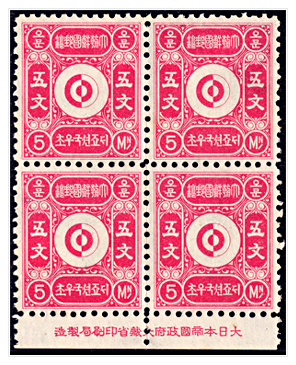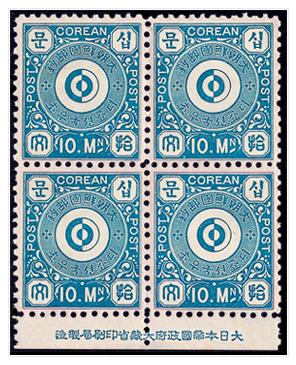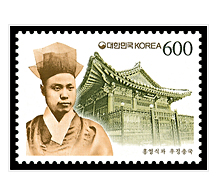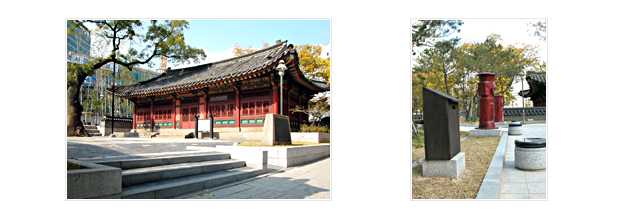(1) Birth of Moon Unit Series

Moon-wi (5 Moon) Stamp

Moon-wi (10 Moon) Stamp

On the bottom side of the stamp appears the letter 大日本帝國政府 大藏省印刷局製造 (Printed by Printing Office of the Treasury of the Great Empire of Japan, which had printed the stamp at that time.
Thanks to the persistent efforts of Mr. Hong Young-Sik (often called the father of modern postal system in Korea) and other young reform-oriented politicians, Woo Jung Chung Guk (Postal Department) had begun operation on November 18, 1884 (October 1 according to the Lunar Calendar). It heralded the first stamp in Korea.
“Moon-wi Stamps” is a nick name given by collectors because the stamp at that time had the denomination in “Moon” (the unit of currency used then).

3 stamps that had never been used, as they did not reach the office until Woo Jung Chung Guk had been closed down.
The Korean Government had delegated the printing of 5 stamps to the Pr-inting Office of the Treasury Department of Japan, with the intention to begin selling them simultaneously with the opening of Woo Jung Chung Guk.
However, only 2 stamps (one in 5 Moon denomination and the other in
10 Moon) had been delivered until the opening day of the office.
The stamps had been used for mails delivered between Han Sung (currently, Seoul) and Incheon.
The remaining 3 stamps (with the denominations of 25 Moon, 50 Moon and 100 Moon) had not been delivered to the office until the closing of Woo Jung Chung Guk following the failed revolution, Gap Sin Jung Byun, on December 4 of the same year.
As a result, the 3 stamps had never been issued.
(2) Mr. Hong Young-Sik, the Founder of Modern Postal Service

Gum Suk Hong Young Sik(1855~1884)
Bon Gwan (official hometown) of Mr. Hong Young-Sik is Nam Yang.
On December 29 of the 6th year of the reign of Chul Jong (1855), he was born a second son of Young Eui Jung (the Prime Minister) Mr. Hong Sun-Mok. His nickname was “Gum Suk.” He was exceptionally bright, winning Chil Suk Si (one of the official examinations administered by the government) at the age of 18. Gum Suk Hong Young-Sik was a leading philosopher of “Gae Hwa (Opening Up)” and politician.
He had ushered in the modern postal service and communication system in Korea, and introduced other advanced culture and technology into Korea.
He had advocated radical reform, and had masterminded a failed coup d’Etat Gap Sin Jung Byun (1884) with Mr. Kim Ok-Kyun. When the revolt had failed in 3 days, he had refused other activists’ advice to seek asylum in a foreign country. While following and protecting. Go Jong (then the King of Korea), he had been killed by Chinese army near the upper stream of Ok Ryu Chun over Chang Duk Palace. He was 30 at that time.
He had been punished by No Ryuk (tearing apart the limbs). But, after the reformist drive, Gap Oh Gyung Jang of 1895, his achievements and contributions had been acknowledged, with his false accusations removed and his rank and status restored.
On 1910, he had been posthumously conferred the title of Dae Jae Hak (doctor) of Gyu Jang Gak (royal college), and he had been appointed Chung Min Gong.
(3) Modern Postal System with Short Life of 20 Days

Central Office of Woo Jung Guk (Postal Service) located at Gyun Ji Dong, Jong Ro Gu, and the mailbox of the time
On December 4, 1884 (18th day since the beginning of postal service), a party was organized, celebrating the opening of Woo Jung Guk (postal office). The party had led to the failed coup d’Etat, Gap Sin Jung Byun.
The coup had been engineered by the reformists such as Hong Young- Sik, Kim Ok-Kyun, Park Young-Ho, Seo Jae-Pil and Lee Sang-Jae. But, the failure had resulted in the demise of not only those behind the coup, but also the reform-oriented intellectuals in general.
Most people involved in the coup had disappeared, and all correspondents and other evidentiary data had been thoroughly destroyed or incinerated. Unfortunately, therefore, very few historical data of the time such as the actually used env-elope or other postal-related materials are available for us.


 Moon-wi (5 Moon) Stamp
Moon-wi (5 Moon) Stamp 
 Moon-wi (10 Moon) Stamp
Moon-wi (10 Moon) Stamp On the bottom side of the stamp appears the letter 大日本帝國政府 大藏省印刷局製造 (Printed by Printing Office of the Treasury of the Great Empire of Japan, which had printed the stamp at that time.
On the bottom side of the stamp appears the letter 大日本帝國政府 大藏省印刷局製造 (Printed by Printing Office of the Treasury of the Great Empire of Japan, which had printed the stamp at that time.
 3 stamps that had never been used, as they did not reach the office until Woo Jung Chung Guk had been closed down.
3 stamps that had never been used, as they did not reach the office until Woo Jung Chung Guk had been closed down. 

 Gum Suk Hong Young Sik(1855~1884)
Gum Suk Hong Young Sik(1855~1884)
 Central Office of Woo Jung Guk (Postal Service) located at Gyun Ji Dong, Jong Ro Gu, and the mailbox of the time
Central Office of Woo Jung Guk (Postal Service) located at Gyun Ji Dong, Jong Ro Gu, and the mailbox of the time